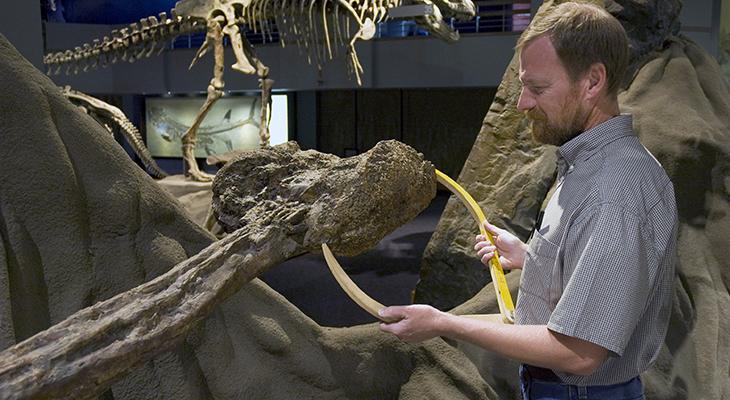To understand what dinosaurs and marine reptiles were like as living animals, Donald Henderson creates computer-animated models. He has developed methods and software for analysis of floating animals, both living and extinct. Using this software, Donald's research has proven that sauropod dinosaurs could float. He has also developed a rigorous, numerical method for estimating body mass of extinct animals. This has allowed Donald to provide new body mass estimates for a range of different pterosaurs (flying reptiles).
Research Interests
- What were animals of the past like as living animals?
- The use of mathematics to study dinosaur locomotion.
- Physics-based research to understand whether dinosaurs could float.
- Estimating the body mass of extinct animals.
- Rates of fossil erosion in Dinosaur Provincial Park.
- Biomechanical comparisons of the bite forces and skull strengths of horned dinosaurs.
Professional Highlights
- A lead researcher on Borealopelta markmitchelli, the world's best-preserved armoured dinosaur.
- A lead researcher on the elasmosaur Albertonectes vanderveldei, which has the most neck vertebrae of any animal (76).
- Developed computer software to test the floating capabilities of dinosaurs.
- Discovered first evidence of iguanodontids in Alberta.
Education
Ph.D., University of Bristol, 1999
B.Sc., University of Toronto, 1992

- Recent Publications
Henderson, D.M. 2024. Lost, hidden, broken, cut: Estimating and interpreting the shapes and masses of damaged assemblages of plesiosaur gastroliths. PeerJ 12: 1–25. https://doi.org/10.7717/peerj.17925
Henderson, D.M. 2024. Using your head: Cranial steering in pterosaurs. The Science of Nature 111(29): 1–9. https://doi.org/10.1007/s00114-024-01915-7
Henderson, D.M. 2023. Growth constraints set an upper limit to theropod dinosaur body size. The Science of Nature 110: 1–8. https://doi.org/10.1007/s00114-023-01832-1
Henderson, D.M., Borkovic, B., Sanchez, J., and Kowalchuk, A.L. 2022. A busy time at the beach: Multiple examples of gregarious dinosaur behaviour inferred from a set of trackways from the Late Cretaceous of Alberta, Canada. Canadian Journal of Earth Sciences 59(9): 608–622. https://doi.org/10.1139/cjes-2021-0069
Sereno, P.C., Myhrvold, N., Henderson, D.M., Fish, F.E., Vidal, D., Baumgart, S., Keillor, T.M., Formoso, K.K., and Conroy, L.L. 2022. Spinosaurus is not an aquatic dinosaur. eLife 2022: 1–15. https://doi.org/10.7554/eLife.80092
Bestwick, J., Unwin, D.M., Henderson, D.M., and Purnell, M.A. 2021. Dental microwear texture analysis along reptile tooth rows: Complex variation with non-dietary variables. Royal Society Open Science 8(2): 1–30. https://doi.org/10.1098/rsos.201754
Rhodes, M.M., Henderson, D.M., and Currie, P.J. 2021. Maniraptoran pelvic musculature highlights evolutionary patterns in theropod locomotion on the line to birds. PeerJ 9: 1–20. https://doi.org/10.7717/peerj.10855
Bishop, P.J., Bates, K.T., Allen, V.R., Henderson, D.M., Randau, M., and Hutchinson, J.R. 2020. Relationships of mass properties and body proportions to locomotor habit in terrestrial Archosauria. Paleobiology46(4): 550–568. https://doi.org/10.1017/pab.2020.47
Brown, C.M., Greenwood, D.R., Kalyniuk, J.K., Braman, D.R., Henderson, D.M., Greenwood, C.L., and Basinger, J.F. 2020. Dietary palaeoecology of an Early Cretaceous armoured dinosaur (Ornithischia; Nodosauridae) based on floral analysis of stomach contents. Royal Society Open Science 7: 1–21. https://doi.org/10.1098/rsos.200305
Contact
Email: don.henderson@gov.ab.ca
For media inquiries:
Marketing & Public Relations
Ashley Makohoniuk
ashley.makohoniuk@gov.ab.ca
